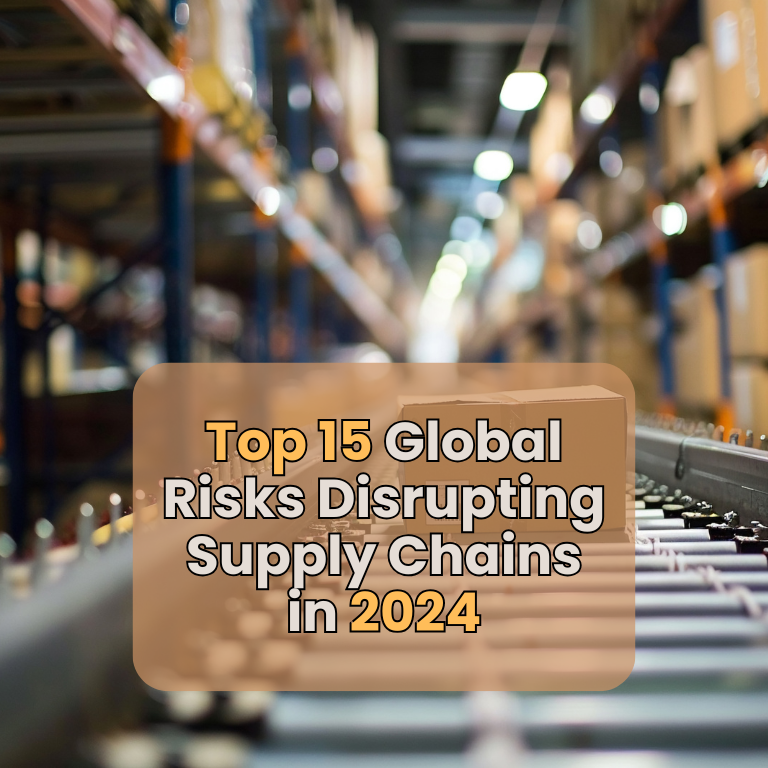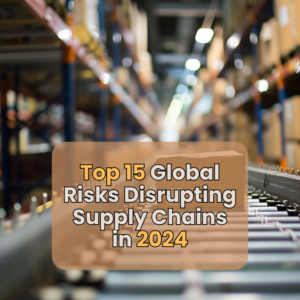Top 15 Global Risks Disrupting Supply Chains in 2024

In today’s interconnected world, supply chains are the backbone of global commerce, moving goods and services across countries and continents. However, with economic uncertainty, political volatility, and climate-related challenges, supply chains are increasingly vulnerable. In 2024, several emerging and ongoing global risks are creating significant disruptions. Here, we explore the top 15 risks impacting supply chains this year and their potential long-term implications for industries worldwide.
1. Geopolitical Tensions and Trade Wars
Geopolitical instability, especially between major economic powers, has led to tariffs, trade barriers, and sanctions. Conflicts between the U.S. and China, for instance, continue to create ripple effects across industries reliant on international trade. As a result, companies are forced to explore alternative suppliers or move production facilities, raising costs and prolonging lead times.
2. Climate Change and Extreme Weather Events
Climate change is not only a long-term environmental threat but a pressing logistical issue for supply chains. Extreme weather events, such as hurricanes, floods, and wildfires, are occurring with greater frequency and intensity, causing infrastructure damage and shipping delays. In regions vulnerable to these events, companies must develop resilient supply chains capable of withstanding climate-related disruptions.
3. Energy Crisis and Rising Fuel Prices
Volatile energy markets, driven by geopolitical issues and increased demand, are leading to unpredictable fuel costs. Higher fuel prices translate to increased transportation costs, affecting the entire supply chain. Additionally, energy shortages in regions like Europe have forced manufacturers to cut production, resulting in delays and shortages downstream.
4. Cybersecurity Threats and Data Breaches
Cyberattacks targeting supply chains have become more frequent and sophisticated. From ransomware attacks to data breaches, companies across industries face digital threats that can halt operations and compromise sensitive information. As supply chains become more reliant on digital platforms, cybersecurity investments are crucial to protect systems and ensure continuity.
5. Labor Shortages and Workforce Challenges
A global shortage of skilled labor has hit manufacturing, logistics, and transportation industries hard. Factors like aging workforces, changes in work preferences, and immigration restrictions have exacerbated labor shortages. Consequently, companies struggle to meet production and delivery demands, leading to increased costs and reduced productivity.
6. Regulatory and Compliance Pressures
Increasing regulatory requirements on environmental standards, labor practices, and health and safety add layers of complexity to supply chain management. In 2024, compliance with environmental, social, and governance (ESG) standards is a priority for many companies, but meeting these regulations often involves high costs and operational adjustments.
7. Global Inflation and Rising Costs
Global inflation remains a significant concern, driving up costs for raw materials, labor, and logistics. Rising costs not only affect product pricing but also challenge profit margins. For companies operating across borders, inflation in one region can have ripple effects throughout the supply chain, affecting overall profitability.
8. Transportation and Shipping Bottlenecks
Ports, particularly in Asia and North America, continue to face congestion issues, delaying shipments and increasing lead times. These bottlenecks are often caused by labor shortages, high cargo volumes, and limited warehousing space. As a result, industries dependent on timely shipping are forced to adapt, leading to increased costs and customer dissatisfaction.
9. Supply Chain Fragmentation and Re-Localization
Global supply chains have become increasingly fragmented due to shifting economic and political landscapes. Many companies are now moving toward re-localization—bringing manufacturing and sourcing closer to end markets—to reduce dependency on single regions or countries. While this strategy adds resilience, it also requires significant investment and time to implement.
10. Currency Fluctuations and Exchange Rate Volatility
Volatile currency markets can have a substantial impact on global supply chains, especially for companies with extensive international operations. Sudden shifts in exchange rates can affect purchasing power, pricing, and profitability, forcing companies to hedge their financial risks or adjust their pricing structures to maintain stability.
11. Raw Material Shortages and Resource Scarcity
The shortage of critical raw materials, such as semiconductors, rare earth metals, and lithium, continues to affect industries like electronics, automotive, and renewable energy. Resource scarcity, often exacerbated by geopolitical issues or natural disasters, disrupts production cycles and forces companies to seek alternative materials or suppliers.
12. Environmental Regulations and Green Supply Chain Initiatives
With growing pressure to adopt sustainable practices, companies are facing stricter environmental regulations on emissions, waste management, and energy use. While these measures are beneficial for the planet, they also create logistical challenges. Businesses must invest in green technologies, rethink their sourcing strategies, and overhaul production methods, all of which come with added costs.
13. Pandemic Resurgence and Public Health Threats
Although the COVID-19 pandemic has largely subsided, new variants and other health threats continue to pose risks. A resurgence of cases could lead to renewed lockdowns, travel restrictions, and workforce disruptions, particularly in manufacturing hubs and densely populated areas. Companies must remain vigilant and prepared for potential health-related disruptions in their supply chains.
14. Technological Shifts and Automation Challenges
While automation and artificial intelligence (AI) offer potential solutions to labor shortages and efficiency issues, they also bring challenges. Implementing new technology requires substantial investment and time, and integrating these tools into existing supply chain systems can disrupt operations. Companies must balance the benefits of automation with the initial complexities and costs of implementation.
15. Consumer Demand Fluctuations and Changing Preferences
Rapid shifts in consumer demand, driven by factors like economic conditions and evolving preferences, are increasingly difficult to predict. Consumers are prioritizing sustainable products, faster delivery, and personalized experiences, putting pressure on companies to adapt quickly. Meeting these demands often requires real-time adjustments to production, logistics, and inventory management, posing challenges for even the most resilient supply chains.
Responding to Supply Chain Disruptions: Strategies for Resilience
With such a wide array of challenges, companies are exploring strategies to build resilience into their supply chains. Here are several effective approaches that businesses are adopting:
Diversifying Suppliers: Relying on a single supplier or region can be risky. By diversifying suppliers, companies can reduce vulnerability to geopolitical tensions, raw material shortages, and natural disasters.
Investing in Technology and Digital Transformation: Advanced digital tools, such as AI, blockchain, and Internet of Things (IoT) sensors, can help companies monitor and manage their supply chains more effectively. Automation and data analytics also offer insights for better decision-making and forecasting.
Implementing Risk Management Protocols: Establishing comprehensive risk management protocols allows companies to identify, assess, and mitigate potential disruptions before they escalate. This includes creating contingency plans for emergencies and investing in insurance policies to cover potential losses.
Focusing on Sustainability: By adopting sustainable practices, companies can meet regulatory requirements while also appealing to environmentally conscious consumers. Sustainable supply chain practices may include reducing emissions, minimizing waste, and adopting green materials.
Enhancing Collaboration and Transparency: Building strong relationships with suppliers, customers, and logistics providers fosters better communication and transparency. Collaborative efforts, such as sharing data on stock levels or anticipated demand, enable companies to respond more swiftly to disruptions.
The Future of Supply Chain Resilience
As global supply chains continue to face unprecedented challenges, resilience has become a key priority for businesses across all industries. Companies are increasingly aware that the risks of relying on outdated or rigid supply chain models outweigh the benefits. The integration of digital technologies, sustainable practices, and diversified supplier networks is essential for supply chains to withstand disruptions and remain agile in an unpredictable world.
While the risks outlined above pose significant challenges, they also present opportunities for innovation. Companies that proactively address these risks can gain a competitive edge, attract environmentally conscious customers, and improve operational efficiencies. As 2024 progresses, organizations that prioritize resilience and adaptability will be better positioned to succeed in a volatile global economy.











